Sonora to Havasu by back roads
There is a HUGE difference between re-locating and traveling. When we are re-locating, we just want to get from point A to point B with as little fuss as possible. But when we are traveling, it’s the journey that matters as much, or sometimes more, than the destination. And so it was today.
We had the option of a quick, highway-based route via I-8, SR-85, I-10 and US-95. This would have taken us thundering down the Interstates, trucks breathing down Howie’s back with every mile, with scenery the likes of truck stop banners bragging sub-$2 gas prices. Instead, we picked some lonely, forgotten roads that deviated from the bird’s flight, took longer, and entertained us a bit along the way. Oh yeah, there was also no traffic to speak of, and we could pull off for photos now and then without risking our lives.
Leaving the intersection of I-8 and AZ-85 for “Old Highway 80”, we followed a route along the Gila River. Our path consisted of long straight stretches along incongruous green farmlands and the Desert Sweet Shrimp company (?), and winding interludes through wildlife refuges and riparian environments. Desert, yes, but with a flare.
In our improving economy, funds seem to be coming available for various public-works projects. Today was no exception, with power-line crews playing bucket-kiss on some new infrastructure. Wouldn’t this be a heck of a blind date?
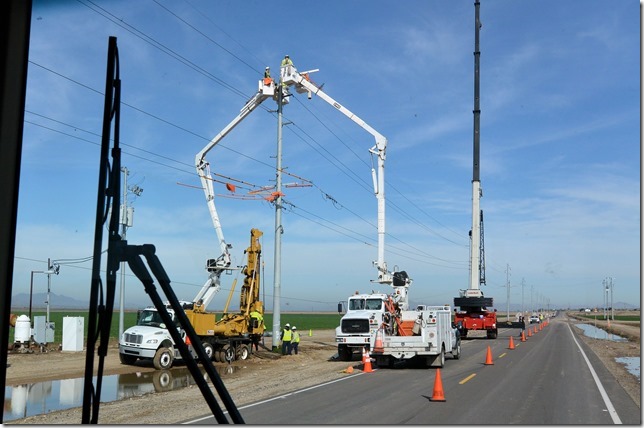
Further along, we drive through the old Gillespie Dam area. Built in 1921, the dam fared pretty well until the winter of 1993. Torrential rains produced flood waters that swelled the Gila to 200,000 cubic feet PER SECOND (that’s 1.6 million gallons). The earth-filled design failed and was never re-built.
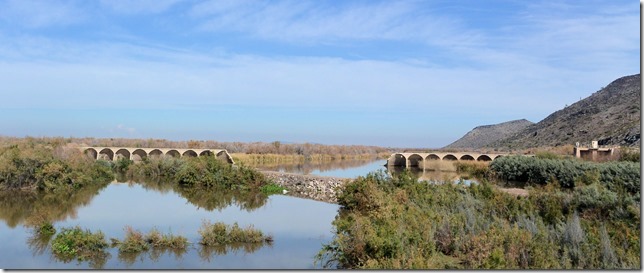
Just downstream, the steel-girder bridge survived, and is in use today (just now by Howie and us). Clearance is only about a foot more than Howie’s eyebrows, so we were craning our necks nervously. No worries, no dings.
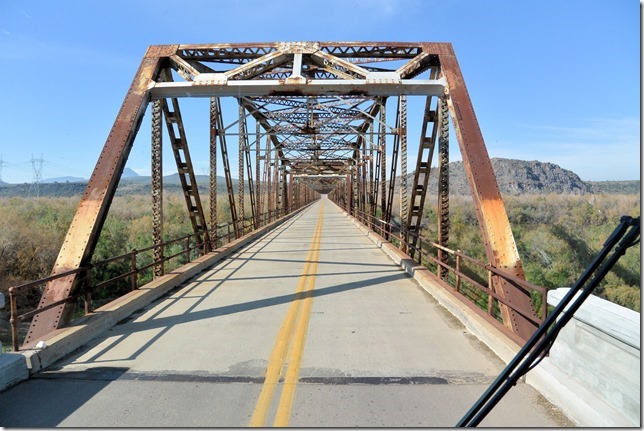
Driving off to the west of the river zone, we topped a hill to discover the farmlands of the Harquahala valley. In stark contrast to the desert from which we emerge, the valley is greened by the Gila and stretches for miles, a seemingly improbable sight.
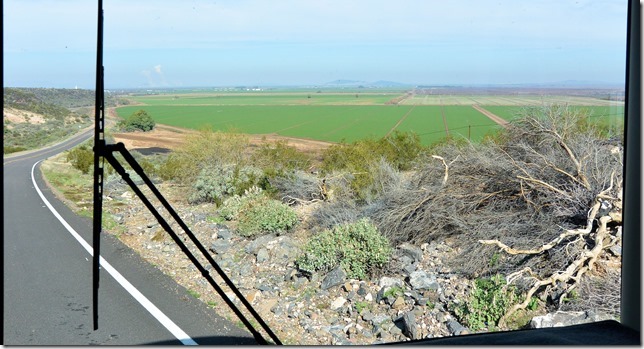
Out west of the “agricultural belt”, an active volcano shows itself on the horizon.
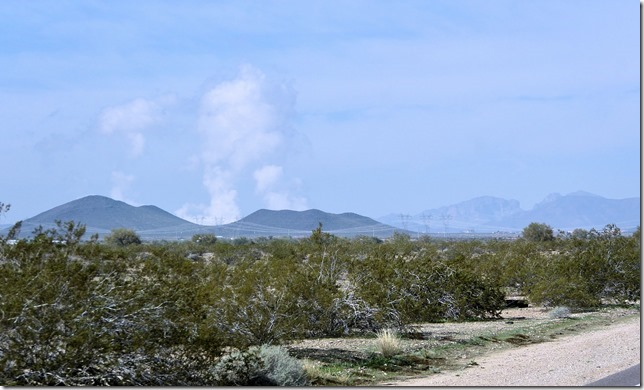
You didn’t buy that one, did you? Nah, of course not. It’s actually the local nuke plant.
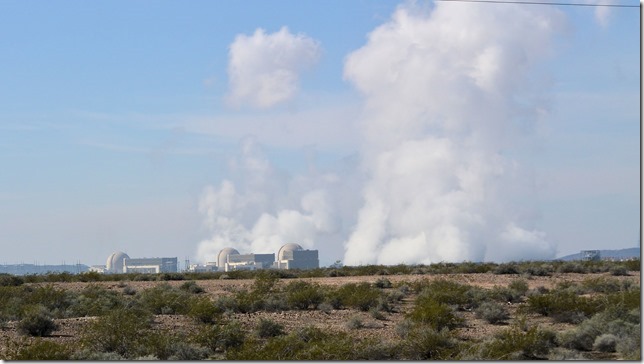
After the entertainment, we crossed I-10 and continued on Salome Road and SR-72. These long lonely tracks cross BLM land, mining claims, and wanna-be ranches, on the way over to US-95 near Parker, AZ. These stretches of desert are by no means as striking as what we’ve recently seen – – but the desert still has its vastness and space, and we enjoyed every mile.
We worked our way through Parker and started looking for a place to stay. The Colorado River is hugely popular this time of year, and the densely-crowded camps along the river were completely full – not that shoulder-to-shoulder camping is of much appeal to us. So we looked earnestly for some BLM opportunities off the east side of US-95.
We found lots of BLM land, but almost nowhere that we could roll Howie any more than a few feet off the highway, the dirt roads were so rough and narrow. Finally, just short of Havasu City, we managed to coax Howie over some fairly mean ruts and dips, and parked him up on a rise. We have a view of the distant Lake, a pleasant neighbor, and some nice evening weather.
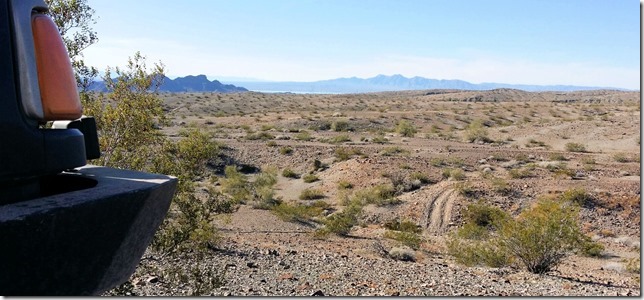
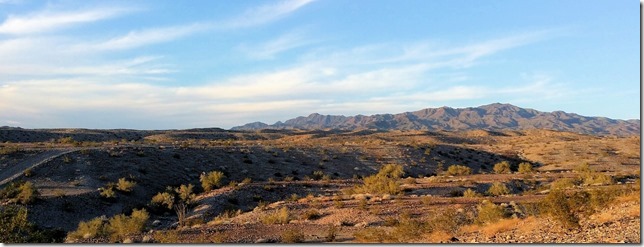
Tomorrow, we pick up an aux tank for Howie and figure out what’s next.
Lastly – – a philosophical mini-essay…..
The spadefoot toad lives in and around the southwestern deserts, and has succeeded at what might seem impossible: an amphibian lifestyle in the desert. We’ve never seen a spadefoot except in Park displays like the one below. The toad survives by hiding underground during harsh (for toads) weather. Turns out, weather in the desert is harsh for toads nearly 50 weeks a year – – the toads self-sustain by digging themselves underground and only emerging after a summer rain, typically to eat (insects) and to mate. Tadpoles are born within 48 hours, and soon are mature enough to be able to dig themselves in as well. They all do this as the weather dries up, after a few weeks at most.
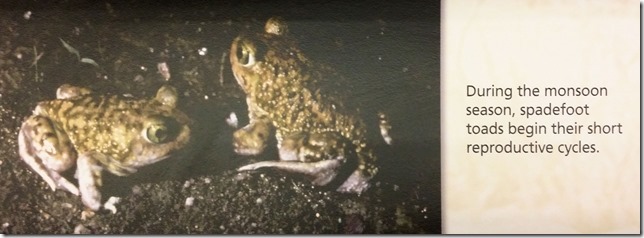
The next time you feel like life is being a little hard on you, ponder being a spadefoot toad. You hide underground until it’s wet outside. You venture forth, try not to get eaten by hawks and snakes, and you try to eat enough to reproduce, not to mention live for a while. You watch your kids get born in two days and grow up in two weeks — and then everybody waves good-bye, and dives underground for another year.
Our human lives are both slower, and faster, generally with more time to “do” and less time to think. As you mull this over, try not to get dirt in your eyes….
Another fabelous one Greg..